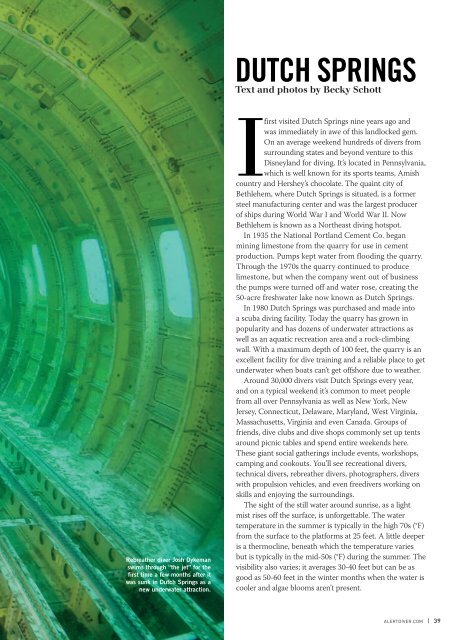AD 2017 Q1
Alert Diver is the dive industry’s leading publication. Featuring DAN’s core content of dive safety, research, education and medical information, each issue is a must-read reference, archived and shared by passionate scuba enthusiasts. In addition, Alert Diver showcases fascinating dive destinations and marine environmental topics through images from the world’s greatest underwater photographers and stories from the most experienced and eloquent dive journalists in the business.
Alert Diver is the dive industry’s leading publication. Featuring DAN’s core content of dive safety, research, education and medical information, each issue is a must-read reference, archived and shared by passionate scuba enthusiasts. In addition, Alert Diver showcases fascinating dive destinations and marine environmental topics through images from the world’s greatest underwater photographers and stories from the most experienced and eloquent dive journalists in the business.
You also want an ePaper? Increase the reach of your titles
YUMPU automatically turns print PDFs into web optimized ePapers that Google loves.
DUTCH SPRINGS<br />
Text and photos by Becky Schott<br />
Rebreather diver Josh Dykeman<br />
swims through “the jet” for the<br />
first time a few months after it<br />
was sunk in Dutch Springs as a<br />
new underwater attraction.<br />
I<br />
first visited Dutch Springs nine years ago and<br />
was immediately in awe of this landlocked gem.<br />
On an average weekend hundreds of divers from<br />
surrounding states and beyond venture to this<br />
Disneyland for diving. It’s located in Pennsylvania,<br />
which is well known for its sports teams, Amish<br />
country and Hershey’s chocolate. The quaint city of<br />
Bethlehem, where Dutch Springs is situated, is a former<br />
steel manufacturing center and was the largest producer<br />
of ships during World War I and World War II. Now<br />
Bethlehem is known as a Northeast diving hotspot.<br />
In 1935 the National Portland Cement Co. began<br />
mining limestone from the quarry for use in cement<br />
production. Pumps kept water from flooding the quarry.<br />
Through the 1970s the quarry continued to produce<br />
limestone, but when the company went out of business<br />
the pumps were turned off and water rose, creating the<br />
50-acre freshwater lake now known as Dutch Springs.<br />
In 1980 Dutch Springs was purchased and made into<br />
a scuba diving facility. Today the quarry has grown in<br />
popularity and has dozens of underwater attractions as<br />
well as an aquatic recreation area and a rock-climbing<br />
wall. With a maximum depth of 100 feet, the quarry is an<br />
excellent facility for dive training and a reliable place to get<br />
underwater when boats can’t get offshore due to weather.<br />
Around 30,000 divers visit Dutch Springs every year,<br />
and on a typical weekend it’s common to meet people<br />
from all over Pennsylvania as well as New York, New<br />
Jersey, Connecticut, Delaware, Maryland, West Virginia,<br />
Massachusetts, Virginia and even Canada. Groups of<br />
friends, dive clubs and dive shops commonly set up tents<br />
around picnic tables and spend entire weekends here.<br />
These giant social gatherings include events, workshops,<br />
camping and cookouts. You’ll see recreational divers,<br />
technical divers, rebreather divers, photographers, divers<br />
with propulsion vehicles, and even freedivers working on<br />
skills and enjoying the surroundings.<br />
The sight of the still water around sunrise, as a light<br />
mist rises off the surface, is unforgettable. The water<br />
temperature in the summer is typically in the high 70s (°F)<br />
from the surface to the platforms at 25 feet. A little deeper<br />
is a thermocline, beneath which the temperature varies<br />
but is typically in the mid-50s (°F) during the summer. The<br />
visibility also varies; it averages 30-40 feet but can be as<br />
good as 50-60 feet in the winter months when the water is<br />
cooler and algae blooms aren’t present.<br />
ALERTDIVER.COM | 39









